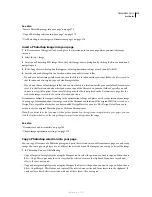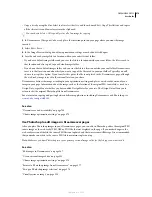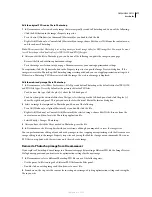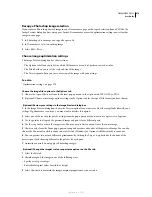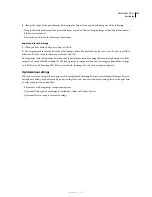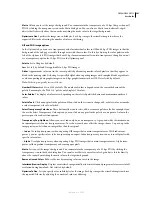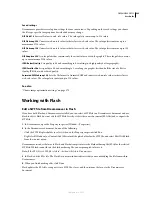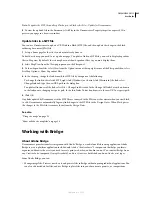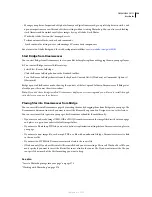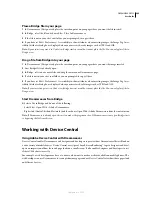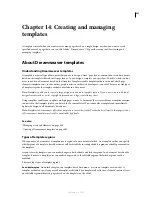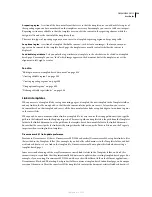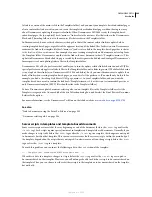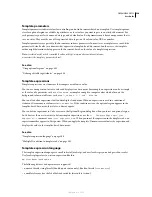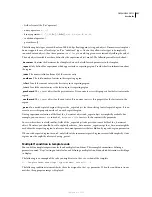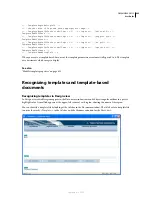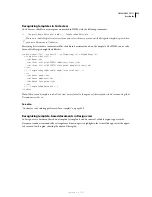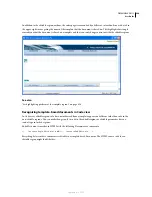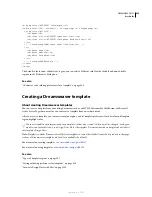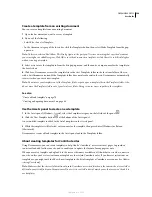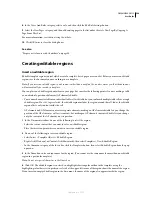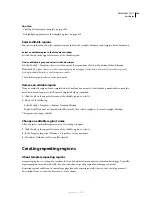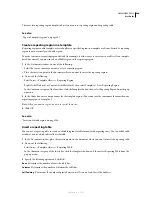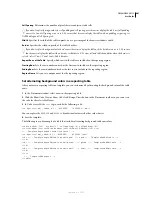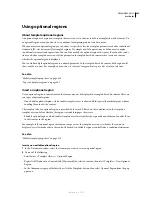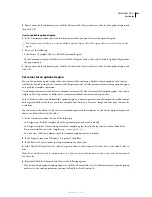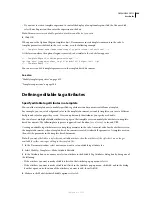
DREAMWEAVER CS3
User Guide
389
(a link to a version of the main.css file in the Templates folder), and you want your template-based index.html pages
also to contain this link as written, you can create the template-based index.html pages without having to worry
about Dreamweaver updating those particular links. When Dreamweaver MX 2004 creates the template-based
index.html pages, the (un-updated) href=”main.css” links refer to the main.css files that reside in the Dreamweaver,
Flash, and Photoshop folders, not to the main.css file that resides in the Templates folder.
In Dreamweaver 8, however, this behavior was changed so that all document-relative links are updated when
creating template-based pages, regardless of the apparent location of the linked files. In this scenario, Dreamweaver
examines the link in the template file (href="main.css") and creates a link in the template-based page that is
relative
to the location of the new document
. For example, if you are creating a template-based document one level up from
the Templates folder, Dreamweaver would write the link in the new document as href=”Templates/main.css”. This
update in Dreamweaver 8 broke links in pages created by those designers who had taken advantage of Dreamweaver’s
former practice of not updating links to files in the Templates folder.
Dreamweaver 8.01 added a preference that enables you to turn the update relative links behavior on and off. (This
special preference only applies to links to files in the Templates folder, not to links in general.) The default behavior
is to
not
update these links (as in Dreamweaver MX 2004 and before), but if you want Dreamweaver to update these
kinds of links when creating template-based pages, you can deselect the preference. (You would only do this if, for
example, you had a Cascading Style Sheets (CSS) page, main.css, in your Templates folder, and you wanted a
template-based document to contain the link href=”Templates/main.css”; but this is not recommended practice as
only Dreamweaver template (DWT) files should reside in the Templates folder.)
To have Dreamweaver update document-relative paths to non-template files in the Templates folder, select the
Templates category on the Advanced tab of the Site Definition dialog box, and deselect the Don’t Rewrite Document
Relative Paths option.
For more information, see the Dreamweaver TechNote on the Adobe website at
www.adobe.com/go/f55d8739
See also
“Link to documents using the Point-To-File icon” on page 283
“Document-relative paths” on page 280
Server scripts in templates and template-based documents
Some server scripts are inserted at the very beginning or end of the document (before the
<html>
tag or after the
</html>
tag). Such scripts require special treatment in templates and template-based documents. Normally, if you
make changes to script code before the
<html>
tag or after the
</html>
tag in a template, the changes are not copied
to documents based on that template. This can cause server errors if other server scripts, within the main body of
the template, depended on the scripts that are not copied. An alert warns you if you change scripts before the
<html>
tag or after the
</html>
tag in a template.
To avoid this problem, you can insert the following code in the
head
section of the template:
<!-- TemplateInfo codeOutsideHTMLIsLocked="true" -->
When this code is in a template, changes to scripts before the
<html>
tag or after the
</html>
tag are copied to
documents based on that template. However, you will no longer be able to edit those scripts in documents based on
the template. Thus, you can choose to either edit these scripts in the template, or in documents based on the template,
but not both.
September 4, 2007

